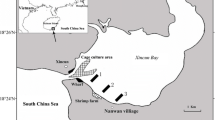Abstract
To determine the impact of damming on the geochemical behavior of dissolved inorganic carbon (DIC) in the Wujiang River basin, field measurements and samples were collected semimonthly for a year. The surface waters of the reservoirs contained concentrations of chlorophyll a up to 5.6 times higher than the upstream river. Compared with the entering waters, the contributions of HCO3 − and dissolved CO2 to DIC decreased, and the contribution of CO3 2− to DIC and the carbon isotopic composition of DIC (δ 13CDIC) increased in the surface waters of the reservoirs, while in the waters released, the DIC species showed reverse geochemical behaviors. The δ 13CDIC ranged from −10.2 ‰ to 2.5 ‰, indicating that significant contributions were from carbonate weathering, photosynthesis, and respiration. After the damming of a river, the bioactivity of phytoplankton was enhanced, and this affected the geochemistry of DIC compared to an unimpacted river and δ 13CDIC can be used to discern these changes. High-frequency monitoring of river-reservoir systems is necessary to evaluate the efflux of CO2 and provide a better understanding of the carbon sinks and sources in the impounded river.




Similar content being viewed by others
References
Yuan D (2001) Carbon cycle in Earth system and its effects on environment and resources. Quat Sci 21:223–232 (in Chinese)
Liu CQ (2007) Biogeochemical processes and matter cycle of the earth’s surface—the basin weathering of south-west karst Area and nutrients elements cycle. Science Press, Beijing (in Chinese)
Meybeck M (1982) Carbon, nitrogen, and phosphorus transport by world rivers. Am J Sci 282:401–450
Ittekkot V (1988) Global trends in the nature of organic matter in the river suspensions. Nature 332:436–438
Rosenberg DM, Mccully P, Pringle CM (2000) Global-scale environmental effects of hydrological alterations introduction. Bioscience 50:746–751
Yu YX, Liu CQ, Wang F et al (2008) Dissolved inorganic carbon and its isotopic differentiation in cascade reservoirs in the Wujiang drainage basin. Chin Sci Bull 53:1935–1941
Myrbo A, Shapley MD (2006) Seasonal water-column dynamics of dissolved inorganic carbon stable isotopic compositions (δ 13CDIC) in small hardwater lakes in Minnesota and Montana. Geochim Cosmochim Acta 70:2699–2714
Maberly SC (1996) Diel, episodic and seasonal changes in pH and concentrations of inorganic carbon in a productive lake. Freshw Biol 35:579–598
Wang M, Zhang LJ, Gui ZS (2011) Spatial and temporal transport of organic carbon in Changjiang mainstream and influence of Three Gorges Project. Period Ocean Univ China 41:117–124 (in Chinese)
Wang S, Yeager KM, Wan G et al (2012) Carbon export and HCO3 − fate in carbonate catchments: a case study in the karst plateau of southwestern China. Appl Geochem 27:64–72
Atekawana EA, Krishnamurthy RV (1998) Seasonal variations of dissolved inorganic carbon and δ 13C of surface water: application of a modified gas evolution technique. J Hydrol 205:265–278
Mackereth FJH, Heron J, Talling JF (1989) Water analysis: some revised methods for limnologists. Freshwater Biological Association, Ambleside
Stumm W, Morgan JJ (1981) Aquatic chemistry. Wiley, New York
Han GL, Liu CQ (2004) Water geochemistry controlled by carbonate dissolution: a study of the river waters draining karst-dominated terrain, Guizhou Province, China. Chem Geol 204:1–21
Wetzel RG (2001) Limnology: lake and river ecosystems. Academic Press, Salt Lake
Aucour AM, Sheppard SM, Guyomar O et al (1999) Use of 13C to trace origin and cycling of inorganic carbon in the Rhône river system. Chem Geol 159:87–105
Zhang Y, Qian X, Qian Y et al (2008) Field measurement and analysis on diurnal stratification in Taihu Lake. Environ Sci Manag 33:117–121 (in Chinese)
Telmer K, Veizer J (1999) Carbon fluxes, pCO2 and substrate weathering in a large northern river basin, Canada: carbon isotope perspectives. Chem Geol 159:61–86
Andrews JE, Greenaway AM, Dennis PF et al (2001) Isotopic effects on inorganic carbon in a tropical river caused by caustic discharges from bauxite processing. Appl Geochem 16:197–206
Wachniew P (2006) Isotopic composition of dissolved inorganic carbon in a large polluted river: The Vistula, Poland. Chem Geol 233:293–308
Wang B, Liu CQ, Wang F et al (2008) The distributions of autumn picoplankton in relation to environmental factors in the reservoirs along the Wujiang River in Guizhou Province, SW China. Hydrobiologia 598:35–45
Acknowledgments
We are grateful to Zhou Yang, Lifeng Cui, Bailing Fan, and Hongming Cai with Institute of Geochemistry, Chinese Academy of Sciences for collecting samples and to Ning An and Longnian Geng with Institute of Geochemistry, Chinese Academy of Sciences for their guidance and help in the measurement of δ 13CDIC. This study was supported by the National Basic Research Program of China (2013CB956703) and the National Natural Science Foundation of China (41021062).
Author information
Authors and Affiliations
Corresponding author
About this article
Cite this article
Peng, X., Liu, CQ., Wang, B. et al. The impact of damming on geochemical behavior of dissolved inorganic carbon in a karst river. Chin. Sci. Bull. 59, 2348–2355 (2014). https://doi.org/10.1007/s11434-014-0153-5
Received:
Accepted:
Published:
Issue Date:
DOI: https://doi.org/10.1007/s11434-014-0153-5




